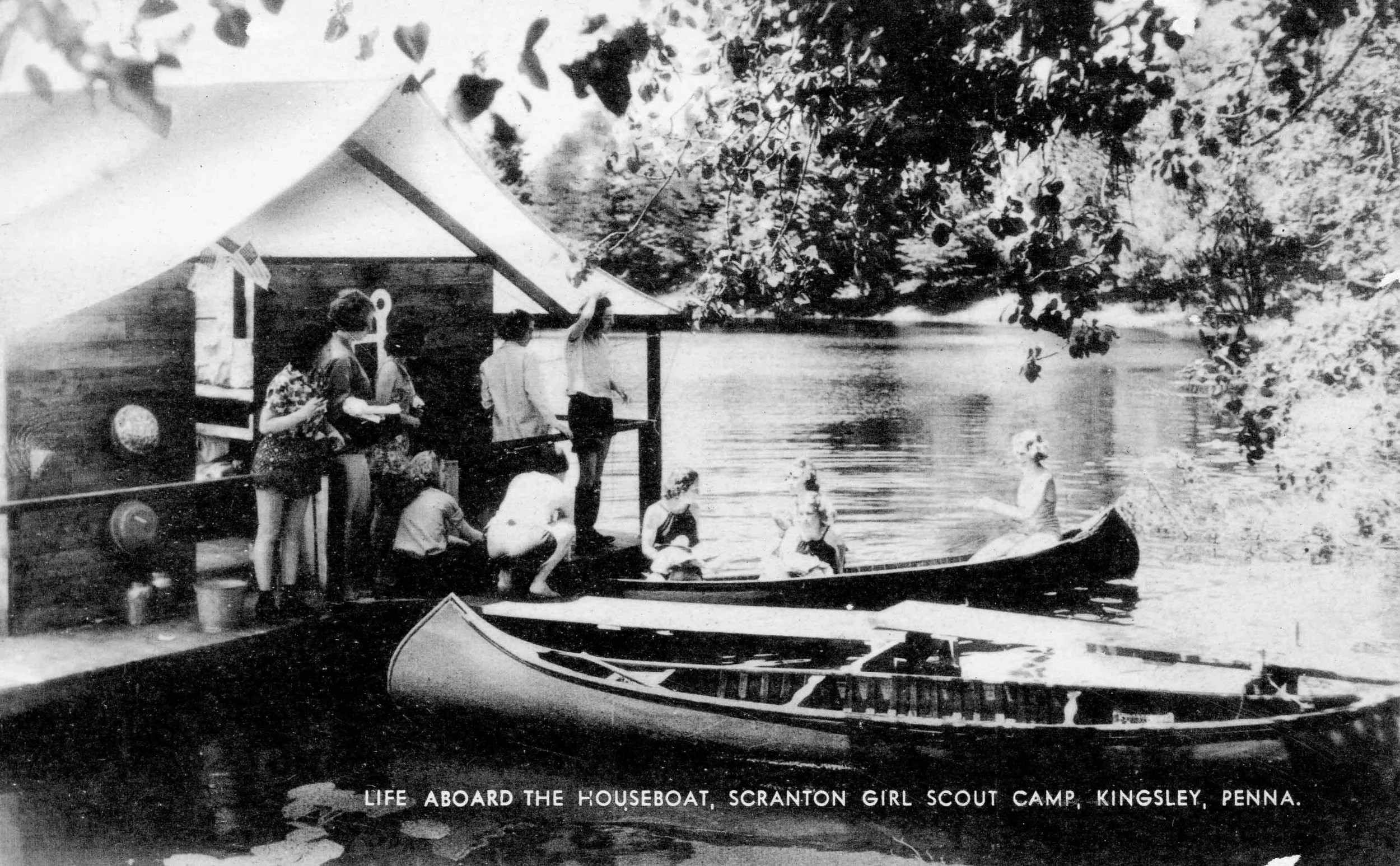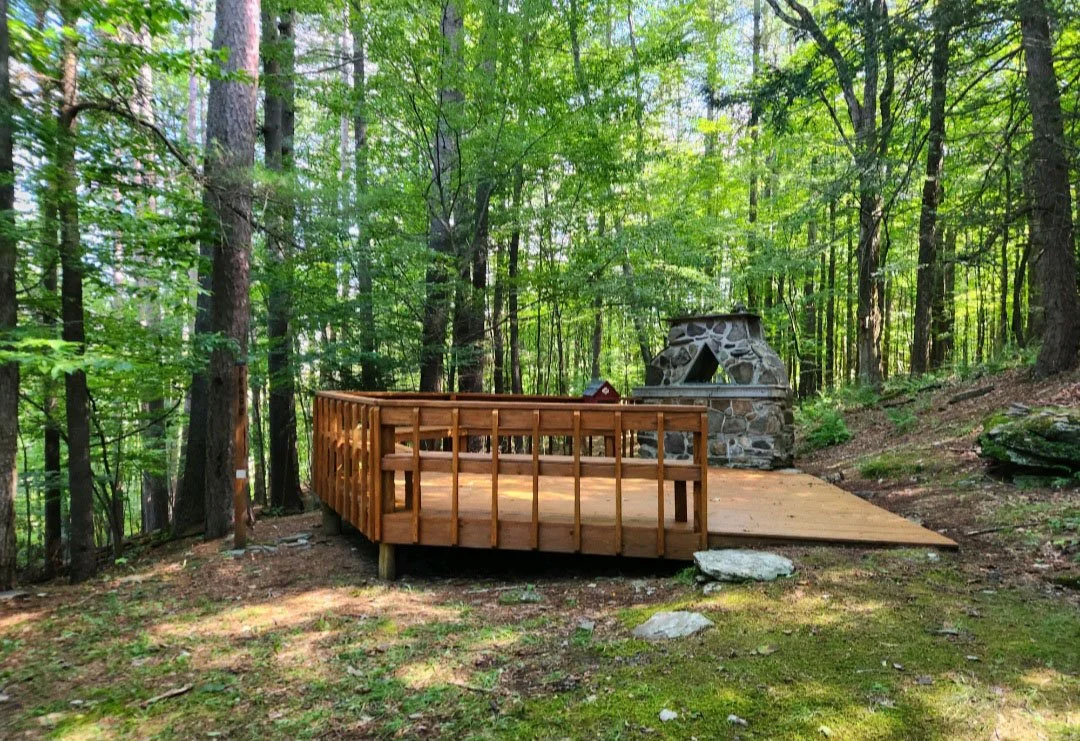
The oldest operating Girl Scout Camp.
Established in 1920, Camp Archbald has a rich history, surrouned by the lore and beauty of its grounds.
A brief history.
Nestled along the captivating shores of Ely Lake in Kingsley, PA, Camp Archbald beckons young girls to a magical haven of adventure and sisterhood. Founded in 1920 by the visionary Scranton Pocono Girl Scout Council, this second oldest Girl Scout Camp globally is a lush expanse of over 9,000 pine trees, echoing with tales of Brownie units and Mariners embarking on pioneering journeys. Historic landmarks like the Trading Post and Schooney Hall weave a tapestry of tradition, while modern wonders like the Laura Muia Dining Hall and thrilling amenities promise an enchanting blend of nature and exploration. Camp Archbald is not just a camp; it's a canvas of dreams painted with the hues of sisterhood, courage, and boundless discovery. Yet, amidst the magic, a bittersweet note rings as portions of this enchanting retreat, crafted with love, were tenderly released by the Scranton Pocono and Girl Scouts in the Heart of Pennsylvania in 2017. Seize the opportunity, young adventurers, and let Camp Archbald be your summer sanctuary where history, nature, and the spirit of Girl Scouts converge in a symphony of enchantment!

“Camp Archbald holds the cherished memories of my childhood summers, where the enchanting blend of towering pine trees, historic landmarks like the Trading Post and Schooney Hall, and the thrill of Lake Ely created a magical haven for adventure and sisterhood. From the echoes of Treetops to the houseboats of Mariners, the camp was a timeless journey through tradition.”
— Former Camper
A longer history.
Camp Archbald, a 288 ½ acre camp, was founded in 1920 by the Scranton Pocono Girl Scout Council at a site in Susquehanna County on the shores of Ely Lake in Kingsley, PA. Archbald is the second oldest Girl Scout Camp in the world. The first purchase of 49 acres in 1921 was paid for through private subscription – the other purchases of land (1926 and 1959) were paid for through the profits of cookie sales. Over 9,000 pine trees have been planted on the property since the first purchase of land in 1921.
Camping for Scranton Pocono Girl Scout Council started in 1918 at Lake Coxton but the location was not right for a permanent home. In 1920, Mrs. Thomas Archbald, the chairperson of a committee to find land, traveled with several women to Brooklyn, PA, where a local resident suggested that they visit Ely Lake. They liked the site and rented land from Shirley Stevens that first summer of camping, deciding afterwards that this would be the permanent home of the council’s first residential camp. In 1921, the camp ran eight weeks of resident camp on the newly-purchased land, with approximately 76 girls attending per week. The girls took the Northern Electric Trolley from Scranton, which stopped a mile from camp. From there, the girls hiked up to camp, with cars or trucks transporting their heavier items. It cost seven dollars a week to attend. For the first five years, the main lawn of today’s camp was where girls and staff pitched their tents. The camp was named after Mrs. Archbald.
Starting in 1925, the camp was divided into units of different levels, a practice that was developed by the national organization, and one that has been followed ever since. The first units were Hillcrest, Hultz (Pioneer) and Greenwood. The very first Brownie unit in the United States was created at Archbald in a unit termed Green Forest (originally Hillcrest) in 1933. The first Mariners unit in any Girl Scout camp was started at Camp Archbald in 1938. Grizzly, a pioneer unit created in 1929, was the site of the first covered wagon ‘Gypsy’ trip undertaken by Girl Scouts in 1933. In 1958, All States Camp was held at Camp Archbald by Girl Scouts of USA. Girls representing every state were in attendance.
The oldest building still on the property is the Trading Post, which was originally built in 1921 to be the administrative offices. It remained as such until the building of the Lodge in 1938, at which point the cottage-style building was converted to the camp store, with a portion used for equipment storage. The waterfront was also one of the first places developed, with the first dock on Ely Lake built by the Scranton Pocono Girl Scout Council in 1922. Even in 1922, the Red Cross safety standards of colored caps that represent swimming ability, unit check-in boards, and a swimming buddy system were strictly enforced by the trained lifeguards.
The most impressive historic building on the property is Schooney Hall built in 1928. W.J. Schoonover immortalized his mother, Roxy Ann, over the fire place with the words, “Best citizens come from the homes where there is a loyal, helpful wife or a loving, practical mother. As a tribute to such a noble woman, this building is presented to the Girl Scouts of Scranton by her son.” Located in the center of camp, the building is made from native PA stone. The stones on the porch and patio are mined from a quarry that was located on the camp property. Pine trees were planted around the building, growing to such an extent that they towered over the building into the early 2000’s. Ultimately, those tree’s roots began to do structural damage to the foundation, porch and steps, resulting in the trees being removed.
The newest facility on the property is the Laura Muia Dining Hall, which was opened in July of 2014, and dedicated to Laura Muia who was a Girl Scout leader and former board member of Scranton Pocono and Girl Scouts in the Heart of Pennsylvania (GSHPA). Other projects completed in 2014 included a new archery range, ropes course, climbing tower and zip line, representing what Jane Ransom, the former CEO of GSHPA, called, “a huge milestone in the plans of GSHPA to reinvest in the outdoor experience of the girls.” It was also the last major investment that GSHPA made in the property before deciding to start selling off portions of the camp in the fall of 2017.
A bit of camp history.
Meet Camp’s Units and Buildings
Support Us.
Help support our mission. Become a member of SoCA, volunteer your time, or help us with a donation. Learn more about how you can help advance our mission and support girls in Northeast Pennsylvania.
















